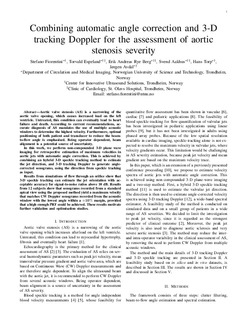| dc.contributor.author | Fiorentini, Stefano | |
| dc.contributor.author | Espeland, Torvald | |
| dc.contributor.author | Berg, Erik Andreas Rye | |
| dc.contributor.author | Aakhus, Svend | |
| dc.contributor.author | Torp, Hans | |
| dc.contributor.author | Avdal, Jørgen | |
| dc.date.accessioned | 2019-11-04T11:03:37Z | |
| dc.date.available | 2019-11-04T11:03:37Z | |
| dc.date.created | 2019-10-01T16:20:29Z | |
| dc.date.issued | 2019 | |
| dc.identifier.citation | IEEE Transactions on Ultrasonics, Ferroelectrics and Frequency Control. 2019, 66 (9), 1404-1412. | nb_NO |
| dc.identifier.issn | 0885-3010 | |
| dc.identifier.uri | http://hdl.handle.net/11250/2626342 | |
| dc.description.abstract | Aortic valve stenosis (AS) is a narrowing of the aortic valve opening, which causes increased load on the left ventricle. Untreated, this condition can eventually lead to heart failure and death. According to current recommendations, an accurate diagnosis of AS mandates the use of multiple acoustic windows to determine the highest velocity. Furthermore, the optimal positioning of both patient and transducer to reduce the beam-to-flow angle is emphasized. Being operator dependent, the beam alignment is a potential source of uncertainty. In this work, we perform noncompounded 3-D plane wave imaging for retrospective estimation of maximum velocities in aortic jets with automatic angle correction. This is achieved by combining a hybrid 3-D speckle tracking method to estimate the jet direction and 3-D tracking Doppler to generate angle-corrected sonograms, using the direction from speckle tracking as input. Results from simulations of flow through an orifice show that 3-D speckle tracking can estimate the jet orientation with acceptable accuracy for signal-to-noise ratios above 10 dB. Results from 12 subjects show that sonograms recorded from a standard apical view using the proposed method yield a maximum velocity that matches continuous wave (CW) Doppler sonograms recorded from the acoustic window with the lowest angle within a ±10% margin, provided that a high enough pulse repetition frequency could be achieved. These results motivate further validation and optimization studies. | nb_NO |
| dc.language.iso | eng | nb_NO |
| dc.publisher | Institute of Electrical and Electronics Engineers (IEEE) | nb_NO |
| dc.title | Combining Automatic Angle Correction and 3-D Tracking Doppler for the Assessment of Aortic Stenosis Severity | nb_NO |
| dc.type | Journal article | nb_NO |
| dc.type | Peer reviewed | nb_NO |
| dc.description.version | acceptedVersion | nb_NO |
| dc.source.pagenumber | 1404-1412 | nb_NO |
| dc.source.volume | 66 | nb_NO |
| dc.source.journal | IEEE Transactions on Ultrasonics, Ferroelectrics and Frequency Control | nb_NO |
| dc.source.issue | 9 | nb_NO |
| dc.identifier.doi | 10.1109/TUFFC.2019.2921818 | |
| dc.identifier.cristin | 1732634 | |
| dc.description.localcode | © 2019 IEEE. Personal use of this material is permitted. Permission from IEEE must be obtained for all other uses, in any current or future media, including reprinting/republishing this material for advertising or promotional purposes, creating new collective works, for resale or redistribution to servers or lists, or reuse of any copyrighted component of this work in other works. | nb_NO |
| cristin.unitcode | 194,65,25,0 | |
| cristin.unitname | Institutt for sirkulasjon og bildediagnostikk | |
| cristin.ispublished | true | |
| cristin.fulltext | postprint | |
| cristin.qualitycode | 1 | |
